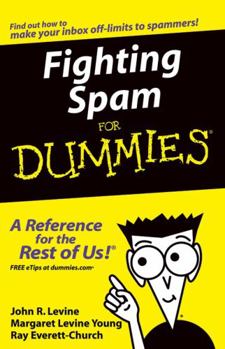Fighting Spam for Dummies
If you have e-mail, you have spam--that annoying electronic junk mail that jams your inbox, sometimes makes you blush, and takes a lot of the fun out of your online experience. Spam wastes thousands of hours and costs you, the recipient of the stuff you don't want, thousands of dollars in increased costs that your Internet service provider eventually passes along to you. In fact, a European survey in 2001 revealed that spam costs about $9.4 billion each year Spammers spam because they're not paying for it, you are. The good news is, you can fight back, and Fighting Spam For Dummies tells you how. Find out Where spam comes from How to set up spam filters How folders help filter out spam What additional programs can help Where--and how--to report spam How best to lobby for spam control You'll get the plai n-English explanation for activating any additional protection offered by your ISP, and discover how to make the best use of any spam filter that came with your e-mail program. Fighting Spam For Dummies will arm you with information about Making your address harder for spammers to grab Why simply hitting "delete" isn't enough Tracking down the source of the spam What you can learn from e-mail headers How spam filters work--and why they aren't foolproof Setting up the maximum level of filtration for your e-mail program and ISP What information your ISP needs when you report spam How--and how not--to complain Adding protection with POPFile Ways to protect your clients if you're a network administrator The ultimate solution to spam has yet to be found, but these Internet-savvy authors give you the tools to help level the playing field. They also offer some solid suggestions for anti-spam laws and how you can join the war on spam.
Format:Paperback
Language:English
ISBN:0764559656
ISBN13:9780764559655
Release Date:January 2004
Publisher:For Dummies
Length:222 Pages
Weight:0.60 lbs.
Dimensions:0.5" x 5.5" x 8.5"
Customer Reviews
2 ratings
one to pay attention to
Published by Thriftbooks.com User , 20 years ago
ISPs should buy this book in bulk and mail it out to every new customer. Then they shouldn't turn on the customer's connectivity until they've passed a test on the contents. If they actually did that, users wouldn't make the silly mistakes like responding to remove instructions to verify their addresses for spammers. I thought I knew everything there was to know about spam, but found myself changing things on my system even before I had completely finished the book. For someone without the time to read the whole book, I'd suggest reading chapters 2,4,5,12 and the one for your specific email client. If you haven't picked an email client yet, and are among the 95% of the world running a windows desktop, I agree with his recommendation to use Eudora. They have a free sponsored version with reasonable filtering. Get the spamnix plugin, learn procmail if your ISP lets you use it, and you're most of the way home to a spam free mailbox. And never, ever respond to remove instructions. It proves that you have a valid email address, that you will read a spam to the bottom to find the remove instructions, and are gullible enough to believe anything a spammer tells you. Spammers love people like that, because that's the kind of person that may actually make them a buck someday.
Limited advice, mostly for end users
Published by Thriftbooks.com User , 21 years ago
A simple book, aimed squarely at the typical email user. Systems administrators wishing for guidance on stopping spam will find little here that they don't already know.Some of the advice, like blocking messages from an undesirable sender, is of limited use. Only works against a spammer who has not forged the sender line. This has been an enduring problem with spam. Likewise, the book offers advice on analysing the header trail. But again, the spammer can control [forge] much of the header data.There is good advice on the opt-in and opt-out mechanisms purportedly offered by several sender companies. Mainstream companies will indeed honour your requests. Good. But, as the book explains, a spammer can turn your request against you, since she now knows that your email address is valid and actively read, which increases the value of it to her.






